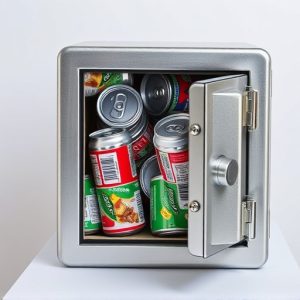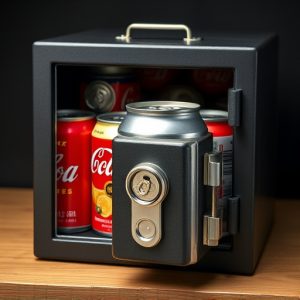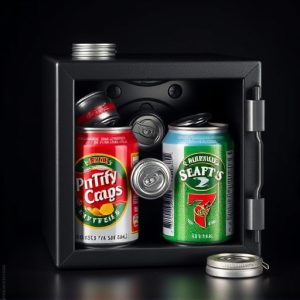Diversion Safes: Unveiling Disguised Food Containers for Secrecy
Covert storage systems, particularly diversion safes disguised as food, offer innovative and seamles…….
Covert storage systems, particularly diversion safes disguised as food, offer innovative and seamless solutions for secure, hidden item storage. These systems integrate into everyday objects like canned goods or faux food products, providing deceptive protection and ensuring only authorized access to concealed compartments. In today's digital age, with heightened security concerns, these disguised food containers have emerged as creative safe options for securing valuable belongings or sensitive documents without drawing attention. The design of successful diversion safes focuses on realism through material selection, texture replication, scent mimicry, and accurate packaging, making them virtually undetectable. Strategically placed in kitchens or other areas, they offer versatile storage solutions for items like prescription medications, essential documents, or small valuables, but raise ethical concerns regarding consent and privacy.
“Uncover the world of covert storage systems, where everyday objects double as secret safes. This article explores the intriguing concept of ‘diversion safes’ designed to look like regular food containers. We delve into the appeal of these disguised safe places, dissecting key design elements that make them effective and virtually undetectable. From creative placement ideas to potential ethical dilemmas, discover the ins and outs of a unique storage solution that could be hiding in plain sight.”
- Understanding Covert Storage Systems: Unveiling the Concept
- The Appeal of Disguised Food Containers as Safe Options
- Design Elements: Crafting an Effective Fake Product
- Placement and Use Cases for Diversion Safes
- Ethical Considerations and Potential Drawbacks
Understanding Covert Storage Systems: Unveiling the Concept
Covert storage systems are innovative solutions designed to provide secure and hidden spaces for valuable items, often integrating seamlessly into everyday objects. One such creative design is the diversion safe disguised as food, a cunning approach to conceal your possessions. These systems offer a unique way to protect sensitive materials or keep precious belongings out of sight while maintaining an innocent appearance.
The concept behind these hidden storage solutions is simple yet brilliant. By masquerading as everyday items like canned goods, books, or even faux food products, they provide a false sense of security, making them virtually undetectable to the untrained eye. This deceptive design ensures that only authorized individuals with knowledge of its existence can access the concealed compartment, offering peace of mind and enhanced security for sensitive materials.
The Appeal of Disguised Food Containers as Safe Options
In today’s digital era, where security concerns are on the rise, innovative solutions like disguised food containers have gained traction as unique diversification safe options. These cleverly designed products offer an appealing alternative to traditional hiding spots, blending seamlessly into household kitchens and pantry spaces. By masquerading as everyday food items, they provide a level of discretion never seen before.
The concept is simple yet effective: create containers that look exactly like common food products, from cereal boxes to mason jars. This deceptive design makes them nearly impossible for intruders to identify as potential hiding places. Whether it’s stashing valuable belongings or keeping sensitive documents secure, these diversion safes offer a creative way to safeguard possessions without drawing unnecessary attention.
Design Elements: Crafting an Effective Fake Product
In designing a successful fake product, particularly for covert storage systems like diversion safes disguised as food items, every detail matters. The product must not only look authentic but also feel and smell genuine to avoid suspicion. Crafting such an item involves meticulous attention to material selection, texture replication, and even scent mimicry. For instance, using realistic-feeling plastics or replicant materials for the outer shell can help fool the eye. Additionally, adding subtle, yet convincing, imperfections can make the fake product appear more authentic, as perfect items rarely exist in everyday life.
The packaging plays a significant role too. Just like a real food item, the diversion safe must be securely packaged with accurate labeling and nutritional information. This includes considering elements like box design, labeling fonts, and even the inclusion of artificial ingredients or additives to make it more convincing. The goal is to create an overall realistic experience that seamlessly integrates into its environment, making it an effective solution for secure, hidden storage.
Placement and Use Cases for Diversion Safes
Placement and use cases for Diversion Safes vary widely due to their innovative design, disguised as everyday items like food. These safes are strategically placed in kitchens, bathrooms, or even bookshelves, seamlessly integrating into home environments. For instance, a Diversion Safe Disguised as Food can serve multiple purposes; it could store prescription medications, essential documents, small valuables, or even emergency supplies.
In offices, they can be used to secure important files and paperwork, while in dormitories or shared living spaces, these safes ensure the safe keeping of personal belongings. Their versatility makes them ideal for anyone seeking discreet and accessible storage, offering peace of mind with their unassuming appearance as common household items.
Ethical Considerations and Potential Drawbacks
The concept of a covert storage system, disguised as everyday items like food, presents intriguing possibilities for homeowners seeking innovative security solutions. However, it’s crucial to explore the ethical considerations and potential drawbacks associated with this approach. One primary concern revolves around consent and privacy. Installing such a system in someone’s home without their knowledge or permission could be viewed as an invasion of privacy, raising serious ethical red flags.
Moreover, the use of diversions like a “faux food” safe might mislead individuals into a false sense of security. If users become overly reliant on these creative hiding spots, they may neglect to implement more traditional and transparent security measures, potentially leaving their properties vulnerable in unforeseen ways. Balancing innovative protection with respect for privacy and an understanding of human behavior is essential when considering the adoption of such unique storage systems.
Covert storage systems, particularly disguised food containers known as diversion safes, offer a unique solution for securing valuables. By seamlessly integrating with everyday objects like kitchen staples, these innovative designs provide a subtle yet effective way to protect important items. However, it’s crucial to balance the appeal of these safes with ethical considerations and potential drawbacks, ensuring their responsible use in enhancing home security while respecting privacy and aesthetics.


